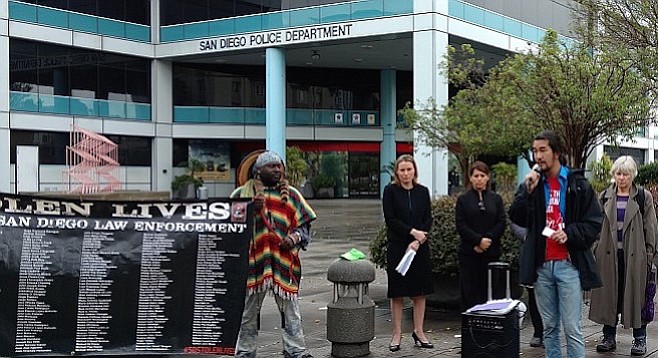 Facebook
Facebook
 X
X
 Instagram
Instagram
 TikTok
TikTok
 Youtube
Youtube

A police watchdog group gathered in front of the San Diego Police Department's downtown headquarters on Monday (January 4) to demand a thorough accounting of what they say are hundreds of deaths at the hands of police in cases dating back three decades or more.
"In San Diego County, we have no comprehensive record of people killed by law enforcement, but we believe such an accounting is a prerequisite for an informed public discussion about the use of force," says Catherine Mendonca, an organizer for United Against Police Terror San Diego. "The mission of our campaign is to demand justice for stolen lives. We're publishing this list to let the public know that we are keeping track.
"We demand a full investigation of every person documented as having been killed by police or having died in police custody, and for full transparency into the involved officers' status, including any discipline that followed," Mendonca continued. "We also demand that law-enforcement agencies establish an 'early warning' system to identify officers that have been involved in an inordinate number of physical force incidents."
Such early-warning systems are not new. A recent report estimated that up to 39 percent of law-enforcement organizations already use them, though poor implementation of the programs has led to few disciplinary actions even in agencies where they're currently deployed.
Activist Bryan Kim used the April 2014 police shooting death of Fridoon Nehad, and the subsequent resistance by police in releasing video of the incident to illustrate what he called a "dramatic need for our police departments to find non-lethal solutions." Nehad was mentally ill and living on the streets in the Midway District when the shooting occurred. He was also unarmed at the time of the conflict.
"Mr. Nehad suffered from post-traumatic stress disorder, as many of our homeless population do. When over one quarter of our homeless population throughout the country suffer from some form of mental health issue, it seems clear that police need training on non-lethal solutions when handling the mentally ill," said Kim. "Anyone who's done work with someone with post-traumatic stress can tell you that rolling up with your sirens blaring and jumping out with a gun pointed while screaming to get on the ground is almost absolutely going to trigger that person, make them non-compliant and make it highly likely that the situation will escalate."
Mendonca said the names on her group's banner — and the more than 400 dead listed on the group's website — included those killed by officers both on and off duty (some were retired), along with border protection and highway patrol officers and security guards with "police grade weapons."


A police watchdog group gathered in front of the San Diego Police Department's downtown headquarters on Monday (January 4) to demand a thorough accounting of what they say are hundreds of deaths at the hands of police in cases dating back three decades or more.
"In San Diego County, we have no comprehensive record of people killed by law enforcement, but we believe such an accounting is a prerequisite for an informed public discussion about the use of force," says Catherine Mendonca, an organizer for United Against Police Terror San Diego. "The mission of our campaign is to demand justice for stolen lives. We're publishing this list to let the public know that we are keeping track.
"We demand a full investigation of every person documented as having been killed by police or having died in police custody, and for full transparency into the involved officers' status, including any discipline that followed," Mendonca continued. "We also demand that law-enforcement agencies establish an 'early warning' system to identify officers that have been involved in an inordinate number of physical force incidents."
Such early-warning systems are not new. A recent report estimated that up to 39 percent of law-enforcement organizations already use them, though poor implementation of the programs has led to few disciplinary actions even in agencies where they're currently deployed.
Activist Bryan Kim used the April 2014 police shooting death of Fridoon Nehad, and the subsequent resistance by police in releasing video of the incident to illustrate what he called a "dramatic need for our police departments to find non-lethal solutions." Nehad was mentally ill and living on the streets in the Midway District when the shooting occurred. He was also unarmed at the time of the conflict.
"Mr. Nehad suffered from post-traumatic stress disorder, as many of our homeless population do. When over one quarter of our homeless population throughout the country suffer from some form of mental health issue, it seems clear that police need training on non-lethal solutions when handling the mentally ill," said Kim. "Anyone who's done work with someone with post-traumatic stress can tell you that rolling up with your sirens blaring and jumping out with a gun pointed while screaming to get on the ground is almost absolutely going to trigger that person, make them non-compliant and make it highly likely that the situation will escalate."
Mendonca said the names on her group's banner — and the more than 400 dead listed on the group's website — included those killed by officers both on and off duty (some were retired), along with border protection and highway patrol officers and security guards with "police grade weapons."
Comments